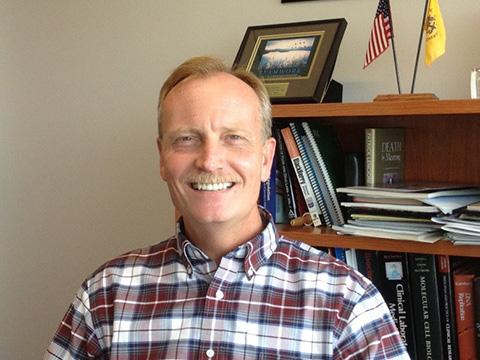
Tom Stackhouse, Ph.D.
After 32 years with the National Cancer Institute, Tom Stackhouse, Ph.D., is riding into the sunset. The director of the Technology Transfer Center retires at the end of June.
Stackhouse transferred from a laboratory role to a fellowship with the center in 1996. There, he found a place to combine his scientific expertise with his passion for helping advance the scientific field. The center supports and enables efforts by NCI and other National Institutes of Health groups to collaborate with others and develop and license inventions. The rest, as they say, is history.
“I was nervous over the fact that I was going to lose my involvement and enjoyment of the science,” Stackhouse recalled of his decision to join the center. Instead, “the science for me became even broader and a real challenge, which I have just absolutely loved that part of it.”
He’s gratified to have had a fulfilling career that helped enable so many partnerships, programs, and products. The team has had several successes, including some in support of the science in Frederick.
Among them, the FNL Cooperative Research and Development Agreement (FNL CRADA) program stands out as one of the biggest. (Previously called “contractor CRADAs” or “cCRADAs,” the program is being renamed this year to align with how other national laboratories refer to their similar programs.)
FNL CRADAs allow Frederick National Laboratory to enter collaborative research and development projects with external groups independently of NCI’s involvement in the research. FNL brings its unique capabilities to bear, advances important research or technology, and is eligible to receive compensation—all at minimal cost to NCI.
The flexibility has been important to FNL’s ability to support and fulfill NCI’s mission, Stackhouse said. “The cCRADA program allows them to do that. It’s still very focused on the NCI mission. It’s still very focused on the programs that are unique to the contract.”
But prior to being implemented in 2010, FNL had no mechanism for doing that independently. The only option was to participate in a federal CRADA, NCI’s own counterpart to the FNL CRADA. It meant much less flexibility.
An Opportunity Realized
The idea for FNL CRADAs in Frederick germinated in the aughts, when several parties started contemplating what it would take to make them possible. Stackhouse, who was the Technology Transfer Center’s unit manager for Frederick at the time, became interested after attending a meeting hosted by a nationwide consortium of federal laboratories’ tech transfer offices. He realized the opportunities available to FNL as a contractor-operated federal laboratory, including having its own CRADA program.
Others soon got involved. Jeffrey Thomas, Ph.D., presently the center’s unit manager for Frederick, was on Stackhouse’s team at the time and joined in the efforts to advocate for an FNL CRADA program.
“It was very rewarding,” Thomas said. “I’m tactics. Tom is strategy. Tom very much had that vision, trying to utilize those [laboratory] authorities in a way that would benefit the mission.”
Support for the program began to accumulate. Senior leaders at NCI and NIH, contract managers in Frederick, the Technology Transfer Center, and FNL’s partnership and intellectual property teams came to a consensus: FNL CRADAs would bring tremendous benefits, leveraging resources provided by NCI while benefiting NCI and the extramural research community.
And they have. Since their implementation 11 years ago, FNL has executed 66 of them. Through the program, the national laboratory has also established more than 20 unique technical services that are available to the external scientific community. These couldn’t be shared without the CRADA authority.
Multiple FNL CRADAs have pushed the envelope of what’s scientifically possible. Through one, FNL helped create a new model for studying HIV. Others illuminated human papillomavirus vaccine immunology and allowed FNL to share world-class cancer models with other researchers, to name a few.
“I thought it was very fulfilling. I would consider it a success of my career to be a part of that,” Stackhouse said of setting up the FNL CRADA program.
In some ways, the ability to execute CRADAs equipped FNL to step into its role as a national laboratory after receiving the designation in 2012. The program created a level of autonomy that’s standard fare for other national laboratories.
“[Tom] was and has always been extremely supportive of the national laboratory and an active member of the Federal Laboratory Consortium for the NCI. He was instrumental in advocating the addition of the CRADA authority to the [FNL’s] contract,” said Claudia Haywood, D.P.A., director of FNL Intellectual Property and Strategic Agreements, the group that executes FNL CRADAs.
A ‘Fantastic Group’ and a Good Mission
Stackhouse’s coworkers are sorry to see him go but agree that his retirement is well earned. Beyond his support for so many initiatives, he has been known for being a unifying, respectful presence who cared for his staff and built bridges with others.
“It’s just been a fantastic group of people to work with,” Thomas said of the Technology Transfer Center’s Frederick unit. “And that all started with Tom as the [past] unit supervisor, … the foundation he laid, trying to have an environment that people are comfortable in, can thrive and have opportunities to grow.”
Meanwhile, Stackhouse appreciates his staff and sees NCI as one of the best places he could’ve worked.
“The mission that we have here is incredible,” he said. “Not only are [we] well supported, … our mission is so clear. We’re there to help cancer patients, and I can’t think of a better mission to work under.”
Samuel Lopez leads the editorial team in Scientific Publications, Graphics & Media (SPGM). He writes for newsletters; informally serves as an institutional historian; and edits scientific manuscripts, corporate documents, and sundry other written media. SPGM is the creative services department and hub for editing, illustration, graphic design, formatting, multimedia, and training in these areas.

